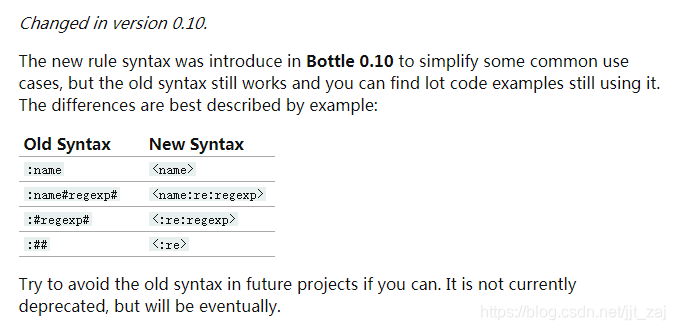web框架
在了解的bottle的时候,我有一个疑问:web框架是什么? 为了解决什么问题使这种框架产生?
我首先整体了解了一下bottle的功能,再去网上查找了一些web框架的信息(web框架理解参考文章)。下边是我的理解:
- web框架启动后提供一个web服务
- web框架对web的各个过程进行了封装。我们知道http协议是一种请求-响应模型。在整个完成过程中,我们需要确定 methods,url(http://ip:port:/uri),header,body,response,response code等信息。这些都由web框架完成
bottle
bottle 是一个快速而简单的、由 Python 包装为一个单一文件的Web 框架.主要功能有:
- 请求静态路由
- 请求动态路由,路由中可包含参数,正则表达
- 指定请求方法,默认为get
- 路由静态文件
- 错误页面
- 自定义header
- cookie的处理
- 指定更改编码
- 状态码的处理
- 页面重定向
- 下载文件
- 使用模板定义输出页面
bottle的简单使用
示例
from bottle import route,run,post,get,request,static_file,error
@route('/he/:name')
def index(name = "world"):
# return '<a href="/login">Go to Hello World Page</a>'
return '<strong>hello {}!'.format(name)
# id是路径中的一个变量,这里表示其值可以是纯数字,一种正则形式
@route('/china/:id#[0-9]+#')
def hh(id):
return 'object id {}'.format(id)
@route("/file/:filename")
def server_file(filename):
return static_file(filename=filename,root='C:\Users\zhangaj\Desktop')
@route('/post_test', method='POST')
def post_test():
data = request.body.read()
logging.info(str(data,encoding='utf8'))
return '接收成功,数据为:'+ str(data,encoding='utf8')
route
route()以括号里的内容作为路径,将下边的函数和其绑定起来,即通过修饰器实现。路径可以有参数,正则表达式- 参数的形式:老版的格式
:name,新版格式<name> - 正则的使用:老版的格式
:name#regexp#,新版本格式<name:re:regexp> - 若返回的有链接,会跳转到另一个页面 见前两个例子。
- 第三个例子是一个加载静态文件的例子,使用函数
static_file - 默认使用
method是get,可指定。见例子4

context= confluence_data.send_content()
@get("/")
def send():
if context == 2:
return "没有获取到页面内容,可能是月份页面不存在"
elif context == 1:
return "没有获取到页面内容,可能是标签不存在"
else:
return '''<form method = "POST">
<input type="submit" value="发送" />
</form>''' + context
@post("/")
def send_post():
return Email.send_mail(context=context)
@get('/login')
def login_form():
return '''<form method = "POST">
<input name="name" type="text" />
<input name="password" type="password" />
<input type="submit" value="Login" />
<input type="submit" value="Logout" />
</form>'''
#@route('/login', method = 'POST')
@post('/login')
def login():
name = request.forms.get('name')
password = request.forms.get('password')
if check_login(name, password):
return '<p>Your login was correct</p>'
else:
return '<p>Login failed</p>'
@error(404)
def error404(error):
return "nothing in there"
# if __name__ =="__main__":
run(host="localhost",port=1234,reloader=True)
- 不同的请求也可以使用如
@get(),@post()这样的方式,和使用route()指定method作用相同 - 同一个路径可以绑定不同的方法,且一个函数可以绑定多个路径(这个没有举例)
error()解析错误,可修改错误返回值。即修改状态码run()运行,启动一个web服务。输入ip和端口就可以在生成页面访问啦,参数reloader=True表示重载工具
模板的使用
示例:
from bottle import route,run,template
@route('/dps/slave/:entid#[0-9]+#')
def DpsPushConfigInfo(entid=None):
keys = "getDpsPushConfigInfo:hset:getConfigHash:" + entid
content = list()
for field in cli.hkeys(keys):
content.append([keys.split(':')[-1], field, cli.hget(name=keys, key=field)])
data = {"data": content}
return template('dps', data)
解析
- 使用模板需引入包
template或view,这里使用的是前者; - 调用方法:在函数结束的时候,调用即可。第一个参数模板文件的名字,其后是需要导入模板的参数(使用字典对)模板的路径为views/下
模板示例:
<!DOCTYPE html>
<html lang="en">
<head>
<meta charset="UTF-8">
<title>dps</title>
</head>
<body>
<table border="1">
<thead><th>节点</th><th>企业</th></thead>
%for slave,entid in data:
<tr><td>{{slave}}</td><td>
%for list_id in entid:
<p><a href="/dps/slave/{{list_id}}">{{list_id}}</a></p>
%end
</td></tr>
%end
</table>
</body>
</html>
解析(模板的官网地址):
- 语法符合html的语法;
- 变量用
{{}}表示起来,大括号内允许使用任何python表达式,只要它的计算结果为字符串或具有字符串表示形式的内容即可; - 一行python代码,用
%表示 - python代码块,用
<% %>表示
参考链接:
官网地址:https://bottlepy.org/docs/dev/
buttle文章: https://blog.youkuaiyun.com/huithe/article/details/8087645







 本文详细介绍了Web框架的概念以及Bottle框架的基本功能,包括路由、请求方法、静态文件处理、错误处理和模板使用。Bottle是一个轻量级的Python Web框架,它使得开发Web应用变得更加简单快捷。通过示例代码展示了如何使用Bottle进行动态路由、请求响应、错误处理以及模板渲染。此外,还解释了模板语法和其实现原理。
本文详细介绍了Web框架的概念以及Bottle框架的基本功能,包括路由、请求方法、静态文件处理、错误处理和模板使用。Bottle是一个轻量级的Python Web框架,它使得开发Web应用变得更加简单快捷。通过示例代码展示了如何使用Bottle进行动态路由、请求响应、错误处理以及模板渲染。此外,还解释了模板语法和其实现原理。
















 148
148

 被折叠的 条评论
为什么被折叠?
被折叠的 条评论
为什么被折叠?








